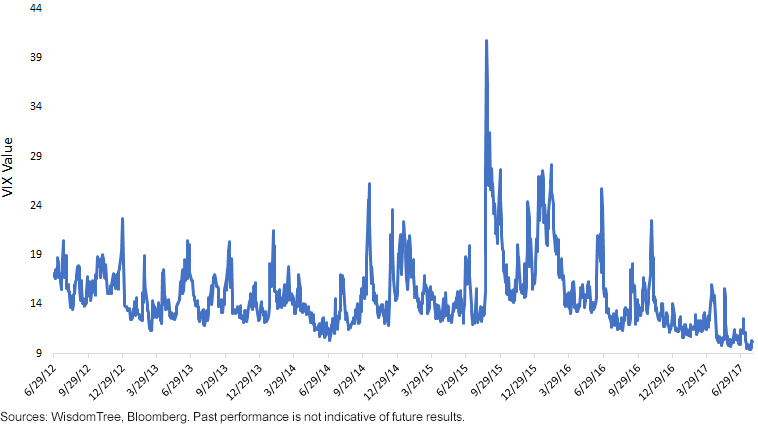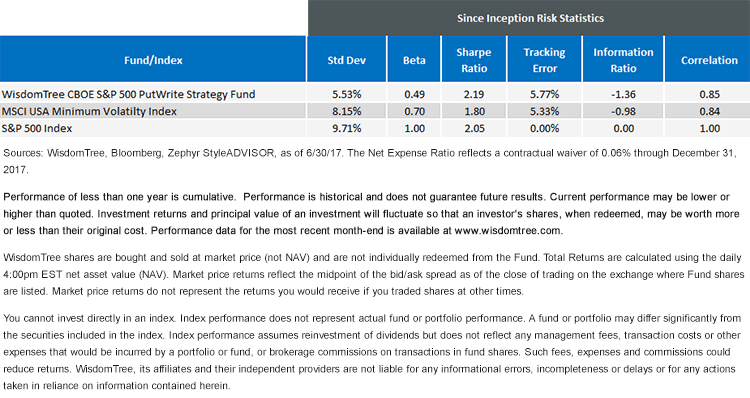Watching The VIX
One of the signatures of the bull market in U.S. stocks over the past five years has been its incredible complacency. One way to visualize the lack of fear in equity markets is to examine the CBOE Volatility Index (the VIX). The VIX, currently trading around 10, scraped a 20-year low of 9.36 on July 21. This is well below its average of the last 20 years, which is about 20.
Figure 1: CBOE Volatility Index, 7/29/12 –7/29/17
(Click on image to enlarge)

The VIX is important because it governs the pricing of options and the premiums investors can collect when writing them on the S&P 500 Index. For most of the last five years, the VIX has averaged about 15, a 25% discount to its historical average. But in recent weeks it has traded between 9 and 11. During periods of unusually low fear in the market, it is not unusual to see investors bidding up stocks to new highs. The current low-volatility environment reminds me a little of the period between late 2004 and May 2006, when the world was also awash in liquidity. Over that period, with volatility grinding ever lower, U.S. equity markets climbed 20% over 20 months, unaware that a historic financial crisis was waiting just around the corner.
These periods of unusually low volatility can continue for months or years, but typically they end with an unforeseen shock to markets that makes such complacency seem surreal in retrospect. For contrarian investors who view today’s complacency as a prelude to an eventual (and highly volatile) reversion to the mean, WisdomTree has a few tools in its tool kit designed to help investors reduce volatility in their portfolios.
Reducing Volatility While Collecting Premiums on the Market
One way to potentially collect option premiums on the S&P 500 Index is by investing in the WisdomTree CBOE S&P 500 PutWrite Strategy Fund (PUTW), which seeks investment results that, before fees and expenses, generally correspond to the performance of the CBOE S&P 500 PutWrite Index (PUT). PUTW invests in one- and three-month Treasury Bills and sells or “writes” S&P 500 Index put options. The Fund writes monthly “at the money” European-style options, and the number of put options sold is chosen to ensure full collateralization. The option premiums the Fund receives from selling puts can help mitigate the negative effects of investing only in investment vehicles that track the S&P 500 Index.
Now that PUTW has nearly a year and a half of real-time history, we can measure how it has performed during a period of historically low volatility in the market. As we can see in figure 2, during this period, when the S&P 500 Index advanced 21% on an annualized basis, PUTW was still able to generate 13% annualized returns—even though it did not own stocks during this period. Notably, over the last year, the combination of owning Treasury Bills and collecting option premiums on the S&P 500 generated returns that exceeded those posted by the MSCI USA Minimum Volatility Index, an equity index, which advanced 8.30% over the same period.
Figure 2: Risk and Return Data for PUTW, 2/24/16–6/30/17
(Click on image to enlarge)

(Click on image to enlarge)

When we drill down to review the standard deviation and beta of the fund based on daily price data over the period, we also noticed that PUTW exhibited much lower volatility than either of the equity indexes, with a beta that was less than half of the S&P 500. This resulted in a Sharpe ratio, a measure of risk-adjusted return, that was higher than the S&P 500 or the MSCI USA Minimum Volatility Index. While these risk-return numbers reflect this particular time period and may not be representative of what investors may experience in a downward trending equity market, it is worth noting PUTW’s potential to generate attractive returns per year, with low volatility, in a period where overall VIX levels were subdued.
Conclusion
Equity investors have enjoyed a period of unusually low volatility in U.S. equity markets. This period of prolonged calm in the market has coincided with an extended upward climb in U.S. stock prices. While these periods of relative complacency can continue for months or years, they can also turn suddenly, because of unforeseen market shocks. PUTW, which has performed well in a period of relative calm in equity markets, has also historically provided a way for investors to lower the overall volatility compared to traditional equity exposures.
Disclaimer: Investors should carefully consider the investment objectives, risks, charges and expenses of the Funds before investing. U.S. investors only: To obtain a prospectus containing this ...
more


